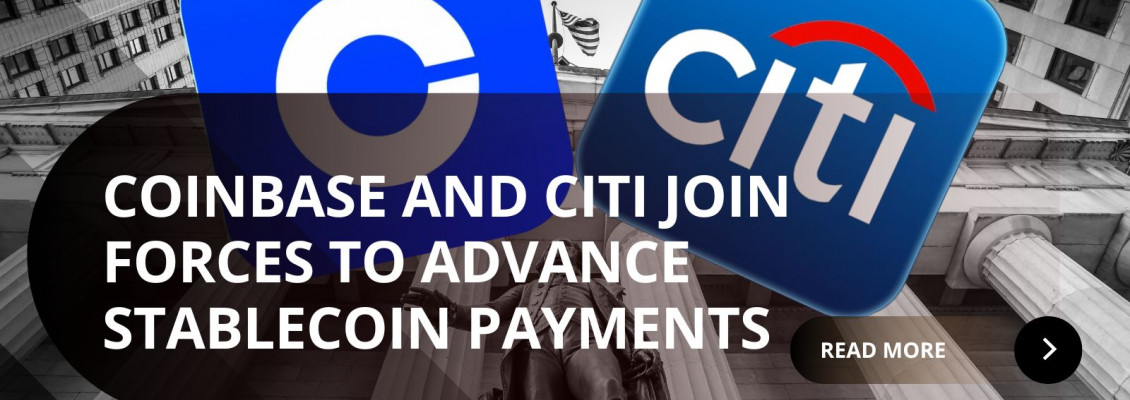
Coinbase and Citi Join Forces to Advance Stablecoin Payments for Institutions
A new chapter in institutional digital asset adoption and payment innovation
In a significant step for the convergence of traditional finance and crypto, Citigroup and Coinbase have partnered to explore digital payment solutions using stablecoins and blockchain infrastructure for Citi’s corporate and institutional clients. This collaboration highlights how digital assets are shifting from speculative use to becoming core financial tools.
What’s Happening
Citigroup and Coinbase are working together to develop digital asset payment capabilities for Citi’s institutional clients. The initiative focuses on simplifying fiat-to-crypto conversions, enabling payouts through stablecoins, and supporting faster, cheaper cross-border transactions using blockchain technology.
For Coinbase, this partnership represents another step in its expansion beyond retail crypto trading into enterprise-grade financial infrastructure. For Citi, it reflects an ongoing commitment to digital innovation, with efforts in stablecoin issuance, tokenized deposits, and blockchain settlement systems.
This partnership is not just about crypto payments. It is about transforming how large financial institutions handle liquidity, treasury operations, and settlement in a global economy that increasingly values speed and transparency.
Why This Matters
1. Digital Assets Move Toward the Financial Mainstream
Just a few years ago, most major banks treated digital assets cautiously. Now, one of the world’s largest banks is partnering with a leading crypto exchange to bring stablecoins into its payments network. This shows that digital assets are maturing into real financial infrastructure.
2. Stablecoins Gain Institutional Utility
Stablecoins are evolving beyond their original use in trading and DeFi. They are now being used for corporate payments, treasury management, and international settlements. Citi and Coinbase are helping push this transition, turning stablecoins into practical tools for global finance.
3. Payment Systems Get a Modern Upgrade
Traditional payment networks can be slow and expensive, often operating only during business hours. Stablecoin transactions on blockchain networks are fast, borderless, and available 24/7. For institutions, that means better liquidity management and reduced friction in cross-border transactions.
4. Banks Are Embracing Partnerships Over Isolation
Rather than developing everything internally, banks like Citi are forming partnerships with crypto-native firms that already understand blockchain technology and digital infrastructure. This approach combines the scale and regulatory experience of traditional banks with the innovation and speed of crypto companies.
The Bigger Picture: Why Now
Several industry and regulatory trends make this collaboration especially timely:
-
Regulatory Clarity: Governments and financial authorities are providing more defined frameworks for stablecoins, making it easier for banks to adopt them responsibly.
-
Stablecoin Growth: Industry research suggests that stablecoins could become a multi-trillion-dollar asset class by the end of the decade, transforming how global businesses move money.
-
Pressure to Innovate: Legacy payment systems are under increasing pressure to modernize. Banks that adopt blockchain rails early will have a competitive advantage in speed and cost efficiency.
-
Partnership-Driven Innovation: The financial world is realizing that collaboration with crypto-native companies is faster and more efficient than building new systems alone.
Challenges and What to Watch
While the partnership is promising, several challenges lie ahead:
-
Scalability: Turning small pilot projects into large-scale enterprise systems will require significant integration with existing banking infrastructure.
-
Compliance: Even with clearer regulations, stablecoin payments must meet strict requirements for anti-money-laundering controls, reserves, and audits.
-
Revenue Impact: If blockchain-based payments significantly reduce transaction costs, banks will need to rethink existing fee structures and profit models.
-
Interoperability: Connecting blockchain rails with legacy systems introduces technical and security complexities that must be addressed.
-
Global Consistency: Citi operates across many jurisdictions, and stablecoin adoption depends on how each region’s regulators treat digital assets.
The Future of Institutional Payments
The collaboration between Coinbase and Citi marks an important moment in the evolution of digital payments and finance. Stablecoins are no longer just a crypto experiment. They are being recognized as real financial instruments that can enhance efficiency, reduce costs, and streamline settlement for global institutions.
This partnership shows the growing alignment between traditional finance and decentralized technology. As more banks and crypto platforms work together, the boundaries between the two worlds are fading. The next era of payments may be powered by stablecoins and tokenized assets, operating on blockchain rails that never sleep.
If successful, the Coinbase–Citi partnership could pave the way for faster global payments, smarter liquidity management, and a more inclusive financial system. The message is clear: the future of money is programmable, and institutions are already laying the groundwork to make it real.
Stay Connected
You can stay up to date on all News, Events, and Marketing of Rare Network, including Rare Evo: America’s Premier Blockchain Conference, happening July 28th-31st, 2026 at The ARIA Resort & Casino, by following our socials on X, LinkedIn, and YouTube.

Leave a Comment